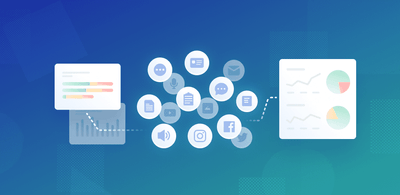What Is Unstructured Data? How to Unlock Its Power

Companies handle all sorts of information every day, from stock and transactional data to emails and social media posts. While some of this data is stored and structured in databases, nearly 80% of business data is unstructured.
Before, it was difficult to gain value from unstructured, resulting in an untapped resource with a huge amount of potential. Luckily, with advancements in machine learning technology, and the accessibility of machine learning software, businesses are now using this data to gain meaningful and more granular insights, in real-time.
However, unstructured data still accounts for the majority of dark data (digital data that goes unused), so what’s stopping businesses from making the most of this data?
Keep reading to learn more about unstructured data, why it’s so important for businesses, and how AI-powered tools can help you easily organize troves of unstructured data in next to no time.
What Is Unstructured Data?

Unstructured data, also known as qualitative data, is disorganized information. It isn’t arranged in a systematic way or format and is difficult to process and analyze using traditional data analysis methods.
Examples of unstructured data in business include:
- Emails
- Reports
- Presentations
- Legal documents
- Online reviews
- Survey responses
- Chats
- Social media data
- Blogs, websites, and comments.
- Videos and calls
Organizations receive huge amounts of unstructured data every day, which is great because it contains valuable insights about how customers feel and why, and helps them understand why a customer churned, for example, or why a customer didn’t finalize their purchase.
But, while this data exists in abundance, it accounts for a lot of dark data, data that isn’t used because it’s hard to process and analyze. Business and IT decision-makers estimate that 55% of their data is dark.
Structured data, or quantitative data, on the contrary, is easy to process and analyze. While it’s valuable, it doesn’t go beyond facts, figures, and trends. In other words, structured data answers ‘what?’ but not ‘why?’. Unlike unstructured data, it’s organized and easily searchable in databases and spreadsheets. Close-ended responses to surveys, star ratings in reviews, and tagged data are some examples of structured data.
In between structured and unstructured data exists semi-structured data. This type of data is partly organized with meta tags, for example, or other elements that assign hierarchy or categories. However, data within each category remains unstructured.
Emails are a great example of semi-structured data: you can tag and search for emails by category (inbox, sent, promotions, spam, etc), but the data within each email is disorganized, and the categories don’t provide an accurate overview of what each email is about.

In a nutshell, unstructured data offers tremendous value for businesses but it’s difficult to store, process, and analyze, making it hard for companies to unlock its full potential.
Manually sorting unstructured data does not scale well either. Imagine, for instance, having to manually tag topics across thousands of survey responses. It’s a time-consuming and tedious task that, if left to humans alone, would result in errors and inconsistencies.
Fortunately, machine learning tools can help businesses to make sense of unstructured data in a fast and simple way. Before we delve into business intelligence tools that can help you make the most of your data, let’s look more closely at why unstructured data is so important.
Why Is Unstructured Data Important?
Unstructured data helps you understand what makes your customers tick and how you can create better customer experiences. By analyzing social media conversations, product reviews, open-ended survey responses, and more, companies can gain valuable insights about their customers, products, and services, which help them make smart, well-informed decisions.
Among other things, analyzing unstructured data can help you:
Improve Customer Service
Unstructured data can help you evaluate the quality of your customer support. Traditionally, customer support teams have been measured against metrics like customer satisfaction (CSAT), First Contact Resolution Rate, and Resolution Rate.
However, by sending out surveys and analyzing open-ended responses, or filtering and analyzing social media conversations that mention customer support, you can find out the reasons for low or high customer support metrics.
NPS responses, for example, could help you understand recurring customer support issues that receive a low score, and lead you to build a self-service knowledge base that can answer these frequent support issues.
Analyze Customer Feedback
When customers share opinions and experiences about a brand on product review sites, on social media platforms, or in survey responses, they generate a wealth of qualitative data that you can collect and analyze.
Customer feedback contains valuable information about what customers like and dislike about your product, service, or company, and can provide key insights to understand their needs and expectations.
Analyzing social media mentions after releasing a new feature for your app, for instance, can help you detect issues, learn more about how customers are using your app, and help you improve your product.
Measure Brand Awareness
Unstructured data can also help you better understand how customers perceive your brand. By monitoring opinions about your brand's image and reputation you can gain insights that go beyond traditional metrics like impressions, reach, likes, shares, and comments, among others.
If you compliment these metrics with an analysis of your customers’ social media posts, you can gain an extra layer of insight, allowing you to understand the nuances of brand mentions and topics that customers mention most.
How to Deal with Unstructured Data?
Traditional computing systems are not well-suited to deal with unstructured data, except for basic indexing and filtering functions. Therefore, until recently, most unstructured data analysis had to be done manually ‒ something that’s costly, time-consuming, and hard to scale.
Machine learning tools uses natural language processing (NLP) to understand, process, and analyze human language, in much the same way as humans, allowing them to extract value from huge amounts of unstructured data in next to no time.
This has revolutionized the way businesses handle large volumes of unstructured data in several ways:
- Automating routine tasks, like ticket tagging and routing
- Analyzing data in real-time, 24/7.
- Instantly scaling operations and soring data quickly and accurately.
One huge advantage of machine learning tools is that they automatically learn from past data samples to make predictions about new data. So, there’s no need to keep re-training them. And since machines are trained to analyze data in the same way, you can be confident that your data is accurate and free from any bias
With machine learning tools, you can automatically classify unstructured data by sentiment, topic, intent, urgency, and more, and extract meaningful information such as keywords, entities (phone number, names), and features, all in real-time.
For example, paste your opinions into this sentiment analyzer, to see how it automatically classifies your data as “Positive”, “Negative”, or “Neutral”.
Maybe you want to use machine learning tools to automatically sort customer feedback by sentiment and topic to gain a clear understanding of your products’ strengths and weaknesses (and even compare them against what's being said about your competitors).
Or, you might want to monitor social mentions by automatically analyzing customer sentiment in real time. This way you can spot unhappy customers on the fly, and handle negative comments faster so that they don't escalate as fast, or at all.
Finally, you might use machine learning tools to automate customer support tasks such as tagging incoming tickets and routing them to the right agents. That way, you can reduce response times and prioritize urgent issues, which results in higher customer satisfaction.
While all this may sound complex, there are many tools available that make machine learning extremely accessible.
Using a no-code tool like MonkeyLearn, which features native integrations and a robust API, you can easily integrate machine learning models with your helpdesk software, and other data sources.
Takeaway
Unstructured data is a rich source of business insight.
Now, machine learning tools are allowing businesses to extract meaningful information in real-time and at scale, whether to support data-driven decisions or automate routine tasks. What used to take hours of tiresome manual processing, can now be done in just a few minutes.
Thanks to no-code, out-of-the-box tools like MonkeyLearn, you can start getting value from your unstructured data right away.
Request a MonkeyLearn demo to learn more about how you can gain value from your unstructured data.

Rachel Wolff
August 26th, 2020







